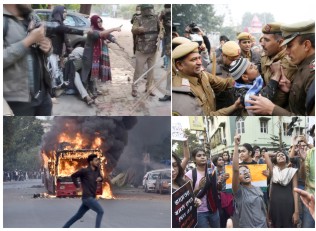Inside the Anti-Citizenship Act protests rocking
India Widespread protests and police brutality
By Sanya Mansoor & Billy Perrigo
As tense protests about India’s new citizenship law rocked the nation’s capital, four women tried to form a human shield around their male classmate as police beat him with sticks. Shaheen Abdulla’s face was bloody as he yelled at his friends to “go inside.”
The women locked eyes with police officers, pointing their fingers at them, urging them to “go away” and leave Abdulla alone. It still hurts. “I feel pain but it’s fine,” she says. As a video of the encounter went viral on social media, Abdulla and his friends quickly became a national symbol for resistance. But he insists that “a lot of heroes came out that night” rescuing each other and sheltering friends. “We are the only people who were caught on camera,” he tells TIME.
Critics also say the law is an affront to India’s secular constitution, which guarantees different religions equal treatment by the government. “The very soul of the Indian freedom struggle and constitution was the idea of equal citizenship for people regardless of their faith,” Harsh Mander, an activist and former civil servant, told TIME before he was detained on Thursday.
“And it’s this that they are destroying.” It was at two historically Muslim universities, Aligharh Muslim University and Jamia Millia Islamia University, where the police response was most violent firing tear gas and beating students, according to testimony heard by TIME and video footage posted online.
Police also stormed the university’s library, firing tear gas at students barricaded inside. Some students hid in the women’s bathrooms, and police entered, began beating people and broke the mirrors, students said. “Students were lying bleeding inside the washroom,” one student who was present told TIME.


